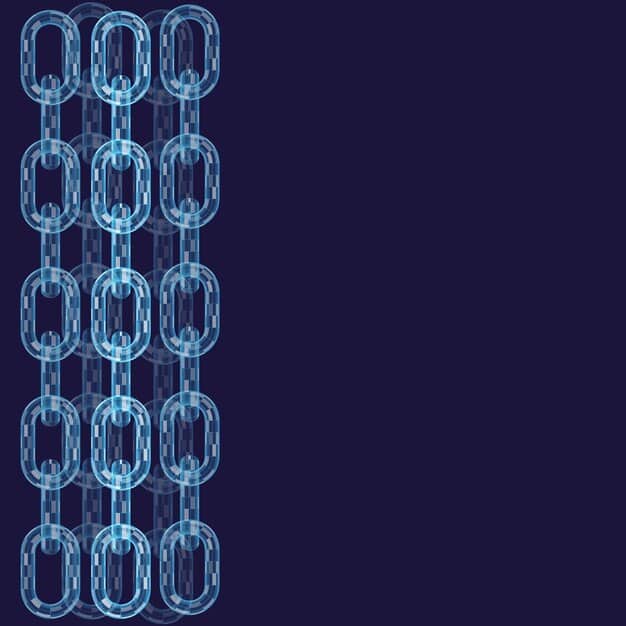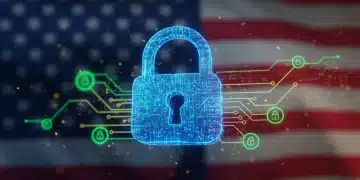Supply Chain Security: Mitigating Risks from Third-Party Vendors

Supply chain security involves protecting the processes, resources, and systems that move products and information. Mitigating risks from third-party vendors requires robust strategies such as due diligence, continuous monitoring, and establishing clear contractual obligations to safeguard against potential vulnerabilities and breaches.
In today’s interconnected business environment, ensuring supply chain security: mitigating risks from third-party vendors is paramount. A single weak link in your vendor network can expose your organization to significant threats, including data breaches, financial losses, and reputational damage. Let’s explore how to fortify your defenses.
Understanding Supply Chain Security and Third-Party Risks
Supply chain security extends beyond physical goods; it encompasses the flow of information, data, and services. Third-party vendors, integral to modern business operations, introduce vulnerabilities that must be addressed proactively. Recognizing these risks is the first step in establishing a robust security posture.
The Scope of Supply Chain Security
Supply chain security involves safeguarding every aspect of the supply chain, from sourcing raw materials to delivering final products or services. This includes physical security, cybersecurity, and information security measures to prevent disruptions, theft, and unauthorized access.
Why Third-Party Vendors Pose a Risk
Third-party vendors, while offering specialized services and expertise, can introduce vulnerabilities into your supply chain. These risks can stem from inadequate security practices, lack of compliance, or even malicious intent. It’s crucial to assess and mitigate these risks to protect your organization’s assets and reputation.
- Data Breaches: Vendors often have access to sensitive data, making them attractive targets for cyberattacks.
- Compliance Violations: Non-compliant vendors can expose your organization to legal and regulatory penalties.
- Operational Disruptions: A security incident at a vendor can disrupt your operations and impact your bottom line.
- Reputational Damage: A breach involving a vendor can damage your organization’s reputation and erode customer trust.
Understanding the scope of supply chain security and the risks posed by third-party vendors is essential for building a resilient security strategy. By identifying potential vulnerabilities and implementing appropriate safeguards, organizations can minimize their exposure to supply chain threats.

Conducting Thorough Vendor Due Diligence
Vendor due diligence is the process of evaluating potential vendors to assess their security posture and identify potential risks. It’s a critical step in ensuring that your supply chain remains secure and resilient. A comprehensive due diligence process should include a variety of assessments and evaluations.
Initial Risk Assessment
Before engaging with any vendor, conduct an initial risk assessment to determine the potential impact of their services on your organization’s security. Consider the types of data they will access, the systems they will interact with, and the potential consequences of a security breach.
Security Questionnaires and Audits
Utilize security questionnaires and audits to gather detailed information about a vendor’s security practices. These tools can help you assess their compliance with industry standards, identify vulnerabilities, and evaluate their overall security maturity.
- SOC 2 Compliance: Evaluate whether the vendor has a SOC 2 report, which provides assurance about their controls related to security, availability, processing integrity, confidentiality, and privacy.
- Penetration Testing: Inquire about the vendor’s penetration testing practices to identify vulnerabilities in their systems and applications.
- Incident Response Plan: Review the vendor’s incident response plan to ensure they have a process in place to effectively respond to security incidents.
Thorough vendor due diligence provides valuable insights into a vendor’s security posture, enabling you to make informed decisions about engaging with them. By identifying and addressing potential risks upfront, you can minimize your exposure to supply chain threats.
Establishing Clear Contractual Obligations
Clear contractual obligations are essential for defining the security responsibilities of your vendors and ensuring accountability. These obligations should be clearly outlined in your contracts and agreements, covering a range of security-related topics. Setting clear expectations from the start can help prevent misunderstandings and ensure compliance.
Security Standards and Compliance Requirements
Specify the security standards and compliance requirements that vendors must adhere to, such as ISO 27001, NIST Cybersecurity Framework, or industry-specific regulations. Clearly define these requirements in your contracts to ensure vendors understand their obligations.
Data Protection and Privacy Clauses
Include data protection and privacy clauses in your contracts to ensure that vendors handle your data securely and in accordance with applicable privacy laws, such as GDPR or CCPA. Specify requirements for data encryption, access controls, and data retention policies.
Incident Reporting and Response Procedures
Outline the procedures for reporting and responding to security incidents in your contracts. Require vendors to notify you promptly of any security breaches or incidents that may impact your organization. Establish clear protocols for investigation, remediation, and communication.
Establishing clear contractual obligations is crucial for setting expectations and ensuring accountability among your vendors. By defining security standards, data protection requirements, and incident response procedures in your contracts, you can minimize the risk of security breaches and protect your organization’s interests.

Implementing Continuous Monitoring and Assessment
Continuous monitoring and assessment are essential for maintaining supply chain security. Regular monitoring allows organizations to identify and address security risks proactively, ensuring that vendors continue to meet security expectations. A proactive approach can help organizations stay ahead of evolving threats.
Regular Security Audits and Assessments
Conduct regular security audits and assessments of your vendors to evaluate their ongoing compliance with security standards and contractual obligations. These audits should cover a range of security controls, including access controls, vulnerability management, and incident response.
Vulnerability Scanning and Penetration Testing
Implement vulnerability scanning and penetration testing to identify potential weaknesses in your vendors’ systems and applications. These tests can help uncover vulnerabilities that may be exploited by attackers.
- Automated Scanning Tools: Use automated scanning tools to identify common vulnerabilities and misconfigurations in vendor systems.
- Regular Penetration Tests: Conduct penetration tests to simulate real-world attacks and assess the effectiveness of vendor security controls.
Continuous monitoring and assessment provide ongoing visibility into the security posture of your vendors, enabling you to identify and address potential risks proactively. By implementing regular audits, vulnerability scanning, and penetration testing, you can ensure that your supply chain remains secure and resilient.
Developing an Incident Response Plan
An incident response plan is a documented set of procedures for responding to security incidents. It outlines the steps to be taken in the event of a breach or other security event, ensuring a coordinated and effective response. A well-defined plan can minimize the impact of incidents and facilitate rapid recovery.
Identifying Key Stakeholders and Responsibilities
Identify key stakeholders and their responsibilities in the incident response plan. This includes internal teams, such as IT, security, legal, and communications, as well as external parties, such as vendors, law enforcement, and regulatory agencies. Clearly define roles and responsibilities to ensure a coordinated response.
Establishing Communication Protocols
Establish clear communication protocols for internal and external stakeholders. This includes channels for reporting incidents, disseminating information, and coordinating response efforts. Ensure that communication channels are secure and reliable.
Testing and Refining the Plan
Regularly test and refine the incident response plan through tabletop exercises, simulations, and real-world incidents. This helps identify gaps in the plan and ensures that stakeholders are familiar with their roles and responsibilities.
Developing a comprehensive incident response plan is essential for minimizing the impact of security incidents and facilitating rapid recovery. By identifying key stakeholders, establishing communication protocols, and testing the plan regularly, organizations can ensure they are prepared to respond effectively to any security event. A well-defined plan is a critical component of a strong supply chain security strategy.
Employee Training and Awareness Programs
Employee training and awareness programs are critical for promoting a culture of security within your organization and among your vendors. Educated employees are more likely to recognize and report potential security threats, reducing the risk of breaches and other incidents. Awareness programs should cover a range of security topics.
Security Awareness Training for Employees
Provide regular security awareness training for all employees, covering topics such as phishing, malware, social engineering, and password security. Emphasize the importance of reporting suspicious activity and following security best practices.
Vendor Security Training and Education
Offer security training and education to your vendors to ensure they understand your security requirements and expectations. This may include providing access to training materials, conducting webinars, or hosting workshops.
- Phishing Simulations: Conduct phishing simulations to test employees’ ability to identify and avoid phishing attacks.
- Regular Security Updates: Provide regular security updates and reminders to keep security top-of-mind.
Employee training and awareness programs are essential for creating a security-conscious culture and reducing the risk of human error. By providing regular training, vendor education, and ongoing communication, organizations can empower their employees and vendors to be active participants in protecting against security threats. A well-informed workforce is a strong defense against evolving cyber risks.
The Future of Supply Chain Security
The future of supply chain security: mitigating risks from third-party vendors will be shaped by emerging technologies, evolving threats, and increasing regulatory scrutiny. Organizations must stay ahead of these trends to maintain a secure and resilient supply chain. Innovation and adaptation are key to future-proofing your security strategy.
Emerging Technologies
Emerging technologies such as blockchain, artificial intelligence (AI), and the Internet of Things (IoT) have the potential to transform supply chain security. Blockchain can enhance transparency and traceability, AI can automate threat detection and response, and IoT can provide real-time visibility into supply chain operations.
Evolving Threat Landscape
The threat landscape is constantly evolving, with new and sophisticated attacks emerging regularly. Organizations must stay informed about the latest threats and vulnerabilities, and adapt their security measures accordingly. Threat intelligence and proactive monitoring are essential for staying ahead of the curve.
The future of supply chain security will require a proactive and adaptive approach. By embracing emerging technologies, staying informed about evolving threats, and collaborating with industry partners, organizations can build more secure and resilient supply chains that are prepared to meet the challenges of tomorrow.
| Key Point | Brief Description |
|---|---|
| 🔍 Due Diligence | Thorough vetting of vendors to assess security posture. |
| 📜 Contractual Obligations | Clear security requirements in vendor contracts. |
| 🛡️ Continuous Monitoring | Ongoing assessment of vendor security performance. |
| 🚨 Incident Response | Plan for handling security incidents involving vendors. |
Frequently Asked Questions (FAQ)
▼
Supply chain security involves protecting the processes, resources, and systems that move products and information from origin to delivery. It includes measures to prevent disruptions, theft, and unauthorized access at every stage.
▼
Third-party vendors can introduce vulnerabilities into your supply chain. Mitigating these risks helps protect your data, ensure compliance, prevent operational disruptions, and safeguard your organization’s reputation from potential harm.
▼
Key steps include conducting an initial risk assessment, using security questionnaires, performing security audits, and checking for SOC 2 compliance. These help evaluate a vendor’s security practices and identify potential risks.
▼
Clear contractual obligations define security responsibilities, mandate compliance with standards, and establish data protection requirements. This ensures vendors are accountable for maintaining a secure environment and protecting your assets.
▼
Employee training promotes a culture of security, ensuring employees recognize and report potential threats. Regular training on topics like phishing and password security reduces the risk of human error and enhances overall security.
Conclusion
Protecting your supply chain from third-party vendor risks is not just a technical challenge; it’s a strategic imperative. By implementing thorough due diligence, establishing clear contractual obligations, continuously monitoring vendor performance, and fostering a culture of security awareness, organizations can significantly mitigate supply chain threats. As the cybersecurity landscape evolves, a proactive and adaptive approach to supply chain security: mitigating risks from third-party vendors will be essential for maintaining business resilience and protecting valuable assets.





